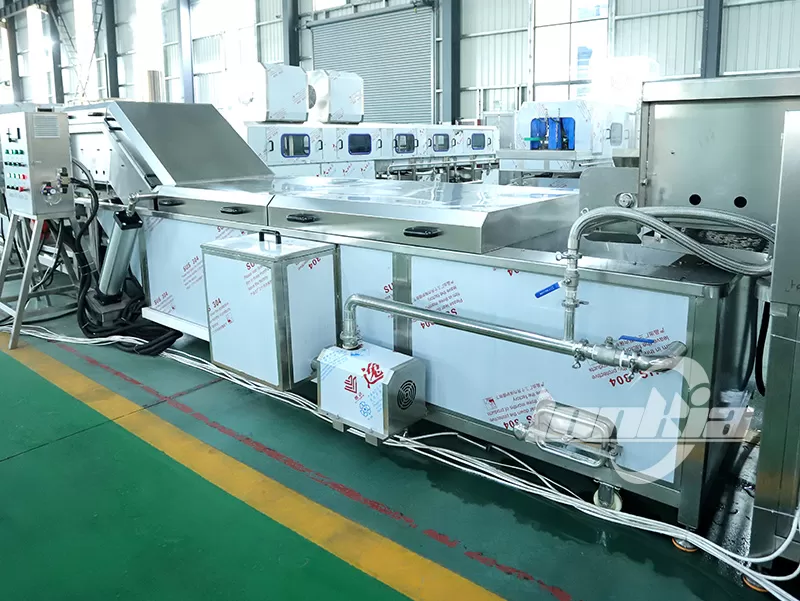The frozen vegetable processing line is a critical equipment system ensuring vegetables undergo multiple processes—including washing, cutting, blanching, cooling, and freezing—within a short timeframe. The design quality of the production line directly impacts the final product's color, texture, nutrient retention rate, as well as the overall line's operational stability and production efficiency. This article analyzes the complete steps of a frozen vegetable processing line—from raw material handling to quick-frozen finished products—based on industry-standard workflows, providing practical reference for factory purchasers.

Vegetable Quick-Freezing Line Workflow
Raw Material Pre-processing: The First Step to Secure Subsequent Processes
Before entering the frozen vegetable processing line, vegetables undergo preliminary sorting. Manual or mechanical sorting equipment removes impurities, spoiled materials, and non-conforming vegetables.
Customer Focus Areas:
- Can labor be reduced?
- Does the equipment support switching between different vegetables?
The stability of pre-processing equipment determines frozen fruit and vegetable processing line efficiency. Unsuitable raw materials increase the burden on subsequent blanching and freezing stages, reducing output capacity.
Washing Stage: Ensuring Vegetable Cleanliness and Impurity Removal
Bubble cleaning machines or brush washers are commonly used for frozen vegetables, enabling multi-angle cleaning. Bubble washing effectively removes sand, soil, and leaf debris, preventing quality issues during freezing.
Key Considerations:
- Is spray pressure evenly distributed across the washer?
- Is the equipment constructed from food-grade materials?
- Is the process gentle enough for fragile vegetables?
Lonkia's washing section typically incorporates a bubble wash + secondary spray rinse design to enhance cleanliness.

Cutting Process: Size Consistency Impacts Final Texture
Vegetables are cut into cubes, slices, strips, or other specifications based on product requirements. The blade assembly structure and rotational speed of the cutter directly affect cutting uniformity.
Customer Focus Areas:
- Cutting size consistency
- Ease of blade replacement
- Compatibility with multiple vegetable types
Higher cutting precision ensures more stable blanching and freezing results.
Blanching Process: A Critical Step for Color Retention and Quality Enhancement
Blanching machines typically use hot water or steam heating to rapidly deactivate enzymes in vegetables, preserving vibrant color.
Factors influencing customer selection:
- Stable heating rate
- Precise temperature control system
- Support for continuous production
Unstable blanching temperatures can cause dull coloration or overcooking, ultimately compromising finished product quality.

Cooling Process: Preventing Residual Heat from Deteriorating Texture
Blanched vegetables are rapidly transferred to ice water or cooling machines to halt heating reactions, locking in texture and nutrients.
Key considerations include:
- Thoroughness of cooling
- Prevention of vegetable breakage
- Energy efficiency of cooling water circulation systems
Inadequate cooling impacts the quick-freezing stage, leading to uneven ice crystal formation.
Quick-Freezing Process: Determines Freezing Effectiveness and Product Appearance
Quick-freezing equipment includes fluidized bed freezers and spiral freezers. Both achieve rapid freezing, producing finer ice crystals to preserve vegetable shape and nutrients.
Key customer concerns: Production capacity and freezing effectiveness.
- Shorter freezing time minimizes nutrient loss
- Does the freezer support continuous operation?
- Is the energy consumption to production capacity ratio reasonable?
Some manufacturers (e.g., Lonkia) offer customizable quick-freezers to accommodate varying plant scales and product requirements.
Sorting and Packaging
After freezing, vegetables pass through sorters to remove debris or substandard items before weighing and packaging. Automated packaging enhances efficiency, reduces human error, and ensures consistent product appearance.
Conclusion
Each step in the frozen vegetable processing line directly impacts final product quality and factory operating costs. Understanding the complete workflow enables customers to accurately assess whether equipment aligns with their production capacity requirements, product portfolio, and budget.
If you are planning to build a frozen vegetable processing plant, feel free to contact us anytime for a customized production solution.

